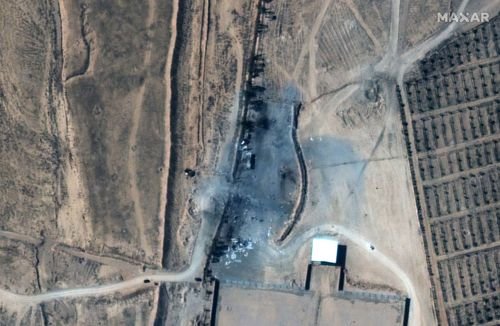Satellite images reveal extent of damage caused by Biden administration’s first military action

The windows blew open. The building shook. At 1:30 a.m. local time Friday, a resident of al-Bukamal, a city near the Syrian-Iraqi border, was jarred from his sleep. Speaking under the condition of anonymity for security reasons, he told CNN the explosions were unlike anything he had heard before.
What he likely heard was the sound of seven 500-pound bombs slamming into a compound near the border. The compound, according to the Pentagon, was used by two Iranian-affiliated Iraqi militias, Kata’ib Hezbollah and Kata’ib Sayyid Al-Shuhada.
Before-and-after satellite images released by Maxar Technologies, a space technology company, show vividly just how much destruction those bombs wrought.
The “before” image shows a compound, just over a third of a kilometer (about 370 yards) from the Iraqi border, containing around a dozen buildings of various sizes. In the “after” image, almost all the buildings have been destroyed, and the dirt in and around the compound blackened by the blasts.
It’s unclear how many militiamen were killed. Kata’ib Hezbollah acknowledged only one dead, without specifying where on the Iraqi-Syrian border he died. A US official said “up to a handful” were killed, while other reports claim anywhere between 17 and 22 people died.
The Pentagon says the strike was intended as a US response to a series of recent rocket and mortar attacks on US and coalition positions in Iraq. On February 15, a volley of rockets fell within the grounds of Erbil’s international airport and in residential parts of the city, killing a contractor while wounding several US personnel and Iraqi civilians. The Green Zone in Baghdad, where the American embassy is located, has been a regular target for mortar and rocket fire. Kata’ib Hezbollah has repeatedly denied any involvement in these attacks, and did so again in a statement released Friday.
Pentagon officials told CNN the compound it targeted was not linked to these attacks but Secretary of Defense Lloyd Austin said he was “confident” it was used by the same militias targeting US and coalition forces in Iraq with rocket attacks.
The armed groups allegedly using it, Kata’ib Hezbollah and Kata’ib Sayyid Al-Shuhada, are just two of a myriad of militias that came to prominence during the war against ISIS in Syria and Iraq, filling the void left by an Iraqi army that was in full retreat.
I spent large stretches of time in 2015 and 2016 with some of those militias as they battled their way north from Baghdad. Some were well organized and disciplined, others radical and volatile.
Their commanders were never shy about the support they received from Iran.
“Yes, we declare to the world, we have Iranian advisers,” Hadi Al-Amari, a senior commander of the pro-Iranian Iraqi Badr Brigades told me in 2015 on the front lines outside the city of Tikrit, then under ISIS control. “We’re proud of them and we thank them deeply for participating with us.”
Nearby, I ran into an Iranian in combat fatigues, who told me in broken Arabic he was a volunteer.
One militia commander told me told me at the time, “it was better to have four Iranian advisers on the front line than 400 American advisers sitting in the Green Zone in Baghdad.”
But that was a different time. The Iranian nuclear agreement was being negotiated. The US and Iran were working, not together but in parallel, to support the Iraqi government in the fight against ISIS.
Since then, the Iraqi militias backed by Iran have grown ever more powerful, while relations between Washington and Tehran have dramatically deteriorated.
The US pulled out of the nuclear agreement under the Trump administration, slapped ever more draconian sanctions on Iran, and on several occasions was on the brink of war, most starkly after the US assassinated in January 2020 Qasem Soleimani, the head of Iran’s Quds Force, and Abu Mahdi Al-Muhandis, deputy head of the Iran-backed Iraqi Popular Mobilization Forces, one of the leaders of the Badr Brigades and a founder of Kata’ib Hezbollah, near Baghdad’s airport.
Now the US finds itself in a situation where it hopes to make it clear it won’t tolerate more attacks by Iranian-backed militias on its positions in Iraq, but at the same time wants to reopen a dialogue with Iran. Sending that message without burning the bridges it’s trying to build to Tehran will be no easy task.
Friday’s strike was the first known military action taken by the Biden administration, making it the seventh US administration in a row to use military force in the Middle East.
Administrations in Washington come. Administrations in Washington go. Some things, however, never change.